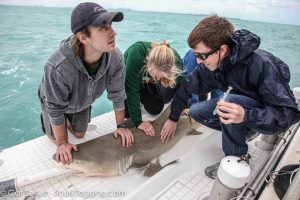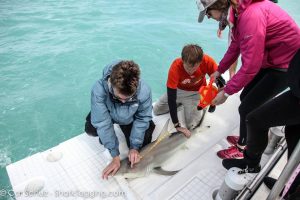Shark tagging with citizen scientists
by Hanover Matz, RJD Intern
On Saturday, February 21st, the RJD team set out with a group of citizen scientists for a fantastic day of research. The morning was cool and windy, with some rough waves offshore. For everyone’s comfort, Captain Eric decided to stay closer to shore that day, taking us to the Safety Valve in Biscayne Bay for our day of tagging. The Safety Valve is a series of sand flats that many different species of sharks frequent. We set up our gear onboard the Diver’s Paradise boat. Each drum weight used to fish for sharks is attached to a buoy and approximately 70 feet of monofilament line. This fishing line is attached to a swivel on the top of the drum weight, allowing any hooked sharks to continuously swim and breathe. Most sharks are ram ventilators, and must continuously swim to pass water over their gills. In addition, circle hooks on the end of the line ensure that the shark is safely hooked in the jaw. Once the gear was onboard, we set out on the water.
The RJD interns explained the work up process to the citizen scientists on the way out to the site. Each guest had the chance to participate in actual scientific research, helping the interns collect date on each shark in the form of nictitating membrane tests, size measurements, and fin clip samples. We reached the site and began deploying our ten drum lines. Each drum line is allowed to soak in the water for 1 hour before it is collected. During this wait interval, the RJD interns and guests collected environmental data. Data on seawater temperature, salinity, and dissolved oxygen content provides information about the abiotic factors different shark species experience.
After 1 hour we returned to collect our lines. On the first set, we pulled in a beautiful female lemon shark. Lemon sharks can be identified from other species by their second dorsal fin, which is almost as large as their first dorsal fin. They also have a brown-yellow color. While the shark was secured on the platform, a pump was placed in its mouth to pump water over its gills. This keeps the shark calm and allows it to breathe during the work up. The citizen scientists assisted the RJD interns with the work up process, helping to put a small tag at the base of the dorsal fin. The work up was quickly completed, and the shark was released back into the water. If the shark is ever caught again, the tag will help identify it to provide data about its movement patterns and life history.

Figure 2: A citizen scientist prepares to administer a nictitating membrane test on a lemon shark. The quick jet of water to the eye helps test the shark’s stress levels and reflex.
The weather remained clear as we continued setting out drum lines. Our next shark of the day was another lemon, but this time it was a male. Male sharks can be differentiated from females by the pair of clasper organs found at the base of their pelvic fins. Length measurements, a fin clip sample, and a blood sample were taken from the shark. These samples provide information about the shark’s health and diet. Blood samples can also be used to determine if the shark has recently been exposed to any diseases. Once the data was collected, the lemon shark was released off the platform.
Our last set of drumlines came up without any sharks, so we set five more lines for one last shot. After waiting an hour, we went back to pull up the lines. Our luck held out: on the last few lines, we caught a third lemon shark and a blacktip shark. Blacktip sharks get their name from the black tips on the edges of their pectoral, dorsal, and caudal fins. These sharks are very fast predators, able to dash off through the water with blinding speed. The sharks were safely secured on the platform at the stern of the boat. With the invaluable assistance of the citizen scientists, the RJD interns collected the necessary data and carefully placed the animals back into the ocean. As the last shark swam off, we were reminded of just how incredible of an opportunity it is to be able to work with such amazing animals. The boat headed back to shore, a successful day of shark tagging behind us.


